That was the whirlwind way we became full-time digital nomads and left for our second trip to Normandy, France in 2018. We’ve been 8 times now and go back every year, normally staying for a month at a time.
From our first trip to Europe in 2016, this beautiful region of France has captured our hearts and we could talk about it for hours.
In an effort to keep the word count down a bit though, this post is focused on visiting the D-Day beaches in Normandy for the first time.
But because we can’t help ourselves, we’ll also pop in fun recommendations outside of the normal museums and tourist sites like where to find an absolutely charming creperie and where to find the French meals we dream about.
In this detailed 3-day itinerary for visiting the Normandy beaches and D-Day sites, you’ll find everything you need to know for planning your first trip to Normandy, France.
TABLE OF CONTENTS
- Planning a Trip to Visit Normandy
- Where to Stay
- Where to Eat in Normandy
- Detailed 3-Day Itinerary for Visiting the Normandy Beaches + D-Day Sites
- Day 1: Train. Museum. Castle.
- Day 2: Omaha Beach, American and German Cemetery
- Day 3: By Land and By Sea On the Way Out
Planning a Trip to Visit Normandy
How many days to visit Normandy?
Normandy is more than a day trip from Paris.
We recommend 3 to 5 days: 3 days if you’re just going for the Normandy beaches and 5 days if you want to see some of the cultural sites as well.
I know there are some guides out there that talk about visiting Mont St. Michel, Bayeux and the Normandy Beaches all in 3 days. But fitting in as much as possible into a day misses a lot of the essence of traveling in Normandy.
A large part of visiting Normandy is relaxing into the pace of life in the French countryside.
Spend an hour in the morning at the weekly market perusing the fresh cheeses and cider.
Take those extra few minutes to learn the stories of the region from your Bed and Breakfast host.
Enjoy the crackle of the fire and the taste of the wine during your 3-hour dinner – complete with a cheese AND dessert course.
Embracing this slow-travel culture takes your Normandy experience to another level.
Save money by visiting the Normandy beaches in the offseason – September to April. We’ve visited Normandy in the winter, spring, and fall and enjoyed the sights each time.
Winter in Normandy can be a bit wet and windy but there are virtually no crowds. Some restaurants might be closed but the museums and sites will still be open.
Some of our favorite memories from visiting Normandy come from visiting in the offseason.
We’ll never forget the time saw a French Dad explain the D-Day Invasion as the “Liberation of France” to his kids at Omaha beach as the French and American flags waved behind him at the same height bringing tears to our eyes.
What’s the weather like?
The invasion of Normandy was actually postponed because of weather – And that was June. Not much has changed on the stormy peninsula where the D-Day beaches of Normandy are located.
In spring and summer, the flowers are blossoming, and the sun comes out more often but the beaches are still windy and you could still have a storm or two so plan and pack accordingly.
How to get to and get around Normandy?
While the cities in France generally have fantastic public transportation, in the countryside – Not so much.
To avoid big bus tours and go at your own pace – rent a car.
The most effective way to get to Normandy from Paris is to take a train to Caen from the Sainte Lazare station and rent a car in Caen.
There might be more convenient train stations closer to where you are staying in Normandy, but Caen has the cheapest rental cars we have seen in the region while still limiting your driving time.
Once you’ve rented your car, getting around Normandy is incredibly simple. There are excellent highways with large markers for all of the D-day sites and towns we’ve included in this guide.
Bonus Tip: You can download Google Maps for the area and get driving directions without needing any data or wifi.
Normandy Travel Tips
Where to stay in Normandy?
For this itinerary, we’ve recommended spending the night near Sainte Mere Eglise.
(Start your search here!)
While I know there are itineraries that would recommend staying in Caen or Bayeux where there are large hotel chains, we highly recommend getting out of the big cities and into the small Norman villages and towns to experience more of the region.
When you’re looking for places to stay in Normandy, search for “bed and breakfasts”, “boutique hotels”, and “gites” (French bed and breakfasts). There are plenty of options.
We stayed in this castle bed and breakfast (technically a chateau) in offseason for far less than the price of a hotel – Chateau de L’Isle Marie (Book Here).
If you’re visiting in the warmer months and want to stay closer to the ocean but still near the D-day sites, we highly recommend the seaside town of Sainte Vaast La Hougue.
This is one of our absolute favorite villages in France and the French love it too (it was voted best French village of the year in 2019).
What to pack for visiting the Normandy beaches?
Besides the normal packing items, we recommend two absolute essentials:
- A rain jacket with a hood – Umbrellas will be tough to manage in the wind
- A guidebook – Our favorite is Rick Steves Normandy Pocket Guide
Where to eat in Normandy?
We have so many favorite restaurants in Normandy. It is honestly some of the best food we’ve had anywhere.
The cheeses, the sauces, the fish, the oysters, the cider… It’s all absolutely delicious.
Here’s a few of our favorite restaurants near the Normandy beaches:
Restaurant L’Auberge John Steele – Sainte Mere Eglise.
This is a beautiful semi-formal restaurant in a stone hotel with good food, good prices, and good service which in France means slow service.
You have the table for the evening so you can enjoy your meal without being hurried. There is no turning over tables – you are their only customer for that table for that evening.
We recommend making a dinner reservation and getting one of the prix fix menu options with a cheese course.
Bistrot 44 – Sainte Mere Eglise.
This is a charming creperie in Sainte Mere Eglise. It’s a great spot to stop for lunch or a café before going to the Airborne Museum.
We recommend sitting with a view of the square and enjoying a relaxing lunch in between sightseeing.
Restaurant L’Omaha – Omaha Beach
This is a great lunch spot to stop at after walking down Omaha beach. We recommend the muscle soup if it’s on special.
Poissonnerie L’Océane – Saint Vaast La Hougue
Enjoy oysters by the pound while watching the fishermen pull their catch of the day straight from the boat to your table. Well not exactly, but it certainly feels like it at this seafood market turned lunchtime gem.
We recommend grabbing an outside table here with some delicious white wine to enjoy lunch in the sunshine with the sounds of the seagulls and water all around you.
La Bisquine Société Guibert – Saint Vaast La Hougue
Have you ever wondered what it would taste like to blend Thai flavors with French cuisine? Well at our favorite restaurant in Normandy you can taste the years of living in Thailand that influenced this French chef.
Between the fresh fish, decadent desserts, and inspired flavors, this is a can’t miss restaurant in Normandy.
Reservations are required.
Restaurant Le Panoramique – Near Saint Vaast La Hougue
This restaurant has one of the best views in Normandy. Whether you go for the more affordable prix fix menu at lunch or watch the sunset over a decadent dinner, this farm to table restaurant is sure to be a memorable French experience.
Reservations are required and their hours may change for the different seasons.
Le Débarcadére – Saint Vaast La Hougue
This is a classic French pub with views of the water for when you’re in the mood for a casual dinner like pizza, local beer, and fresh frites.
Detailed 3 Day Itinerary for Visiting the Normandy Beaches +
D-Day Sites
Day 1: Train. Museum. Castle.
Obviously, the Normandy beaches no longer look like a war zone and there are very few signs explaining the events on site so to really get the context it’s best to visit at least one museum.
The goal here is to be able to visualize what happened on D-day while you’re at the beaches.
For a great overview of the Normandy invasion, visit the Utah Beach Museum.
For the Band of Brothers fans out there who want to know more about the pre-D-Day landings, go to the Airborne Museum in Sainte Mere Eglise.
Follow the path of the soldiers who landed in the town at this museum – including the guy hanging from the steeple on the church in Sainte Mere Eglise.
Day 2: Omaha Beach, the American Cemetery and the German Cemetery
Omaha Beach had the highest casualties and is familiar for movies like Saving Private Ryan.
It’s an incredibly moving experience standing on the beach where so many died just to restore peace when it was ruined by one man surrounded by those who enabled him and gave him power to act.
As you’re walking Omaha Beach stop in for lunch where President Eisenhower ate – Restaurant L’Omaha.
After lunch visit the American Cemetery just over the hill and then the German cemetery.
Coming to military cemeteries as opposed to civilian cemeteries is a much different experience because all the lives here were absolutely taken.
Imagine each headstone is a twenty-year-old kid who sacrificed sixty years of life he would have lived. Now see the second headstone – you’re looking at a hundred and twenty years of combined sacrificed life. Multiply that by a single row and you’re looking at thousands of years.
Please consider the same weight of human life lost from all countries involved.
At the German cemetery each one of these lives lost was fought for ideals we don’t agree with, but it’s so important to recognize the humanity on both sides.
Day 3: By Land and By Sea On the Way Out
Let’s go to two more World War Two sites in Normandy on your way back to returning your rental car – Pointe du Hoc and Arromanches.
Pointe du Hoc shows the absolute magnitude of war better than any other site we’ve seen.
Pointe du Hoc had German artillery aimed at Omaha and Utah Beach so the Americans scaled the cliffs here to destroy those guns. Destruction is everywhere still.
Look down into the craters caused by air raids.
Place your fingers inside bullet and grenade marks in the walls.
Walk inside a German bunker to see the charred wood on the ceiling from flamethrowers.
Stand exactly where history happened.
After the success of D-day, the Allies needed a way to get the tanks and supplies onto the beach to continue the liberation of France and the only way to do that was to build a temporary floating Harbor.
The Utah Beach Museum has an exhibit at the end of the walkthrough that explains how this port was built and it’s absolutely fascinating.
Sunk ships off the coast calmed the waters around what would be the port of Arromanches. While it was only meant to be temporary, many pieces of the harbor remain there today and do their job of calming the waters.
After all, the war only makes up a small window of time in this beautiful part of the world.
Although it was wrecked by war decades ago, there is a peaceful and serene tone to Normandy that has captured our hearts and we’ve fallen in love with the Normandy of today. It’s been a soft and inviting place for us to return to again and again.
Here are a few videos we’ve made to help you plan your trip:
- 5 Reasons for Visiting Normandy
- Living in France Vs. Living in LA
- How to Pack for a Long Trip in a Carry On
What questions can we answer about your upcoming trip to Normandy and D-Day Beaches?
Drop us a comment below!
Did you find this post helpful and informative? Save it for later on Pinterest!

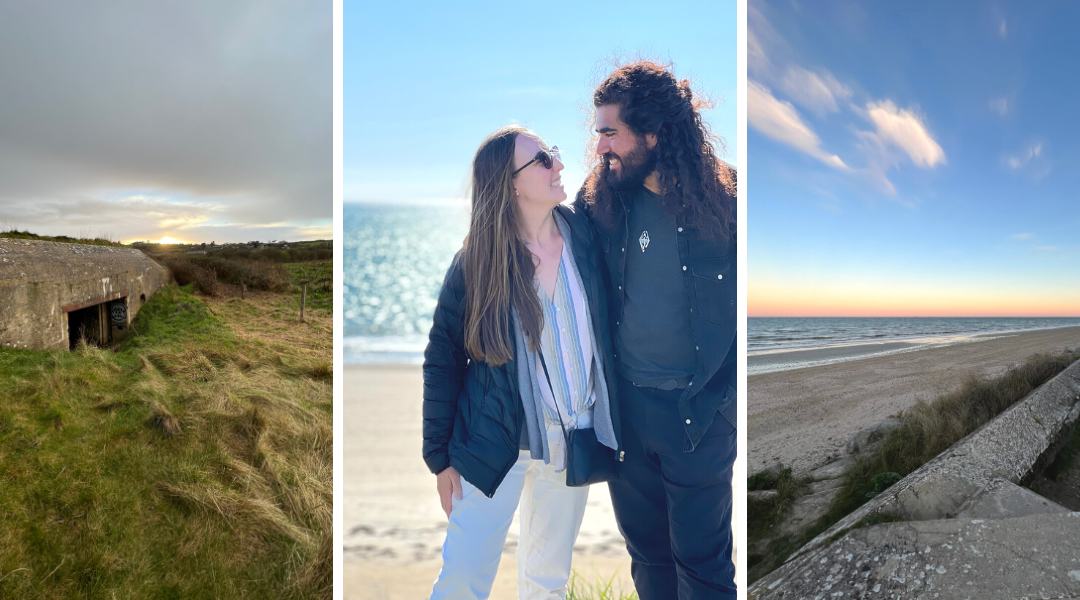
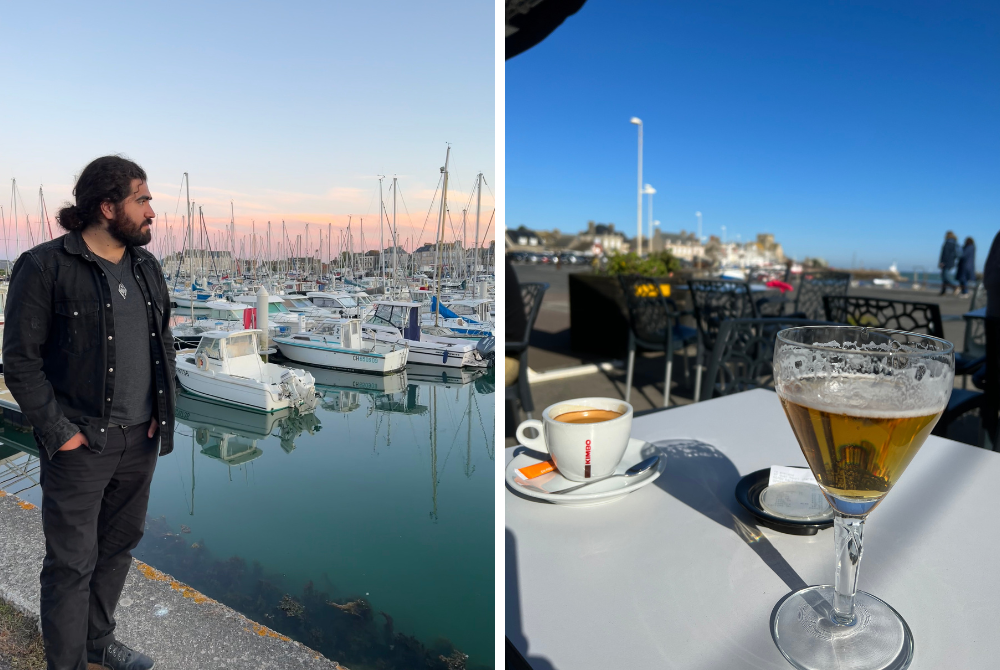
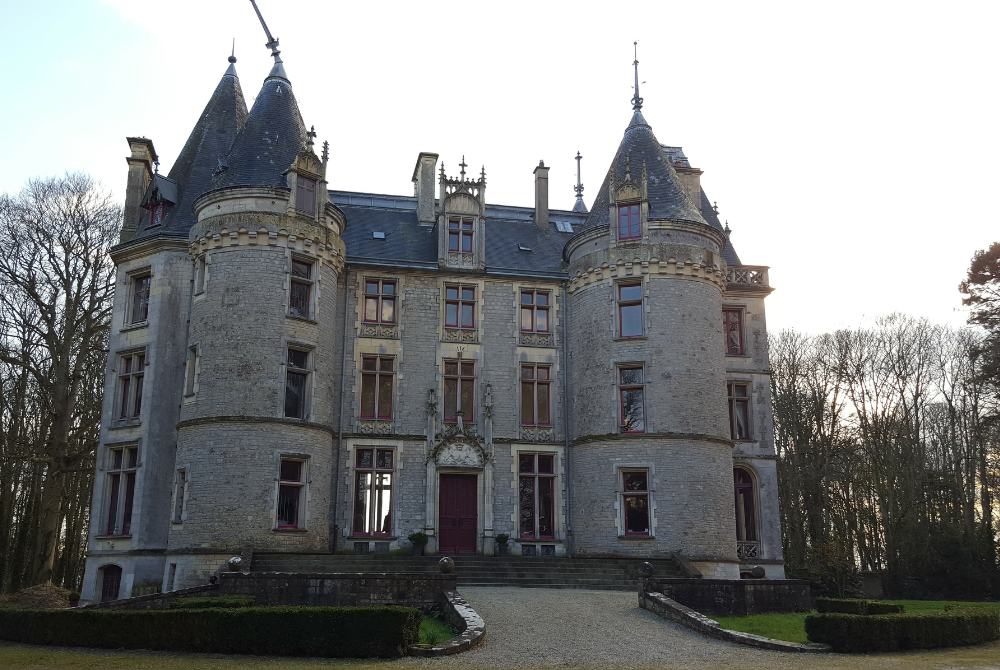
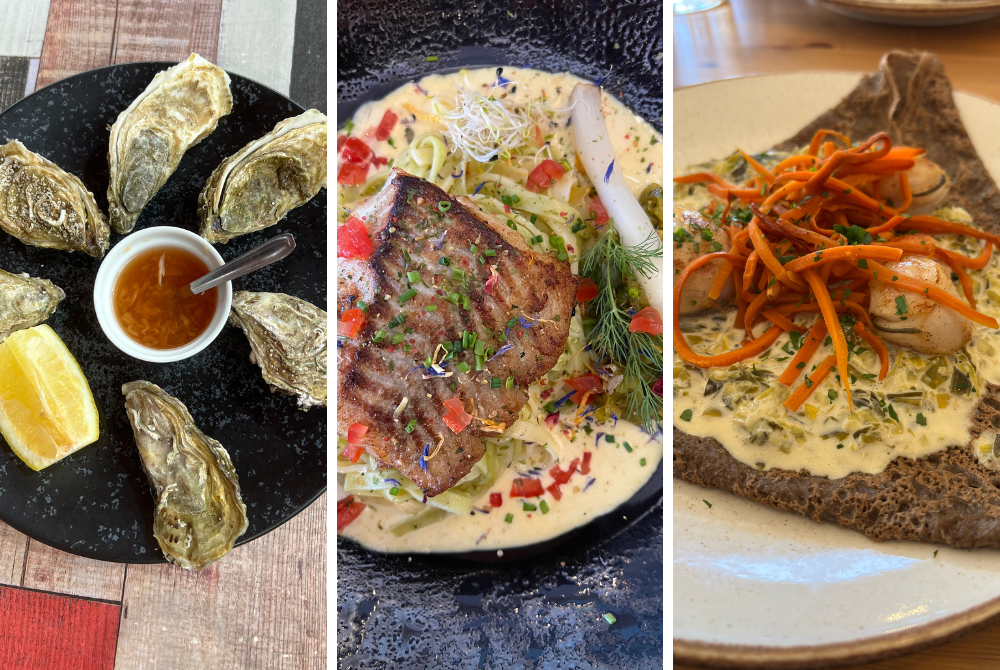
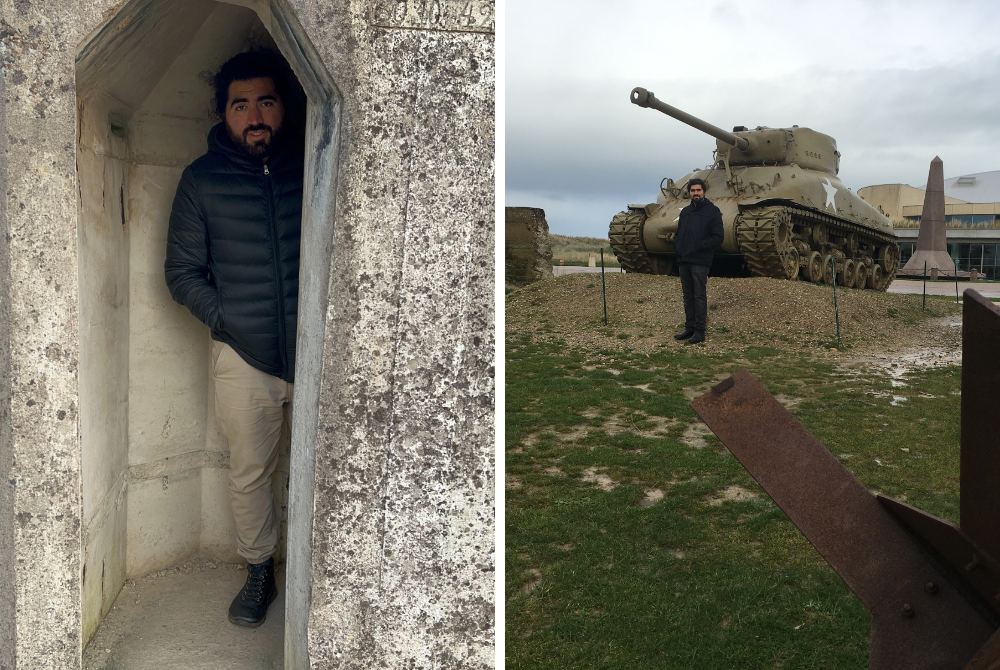
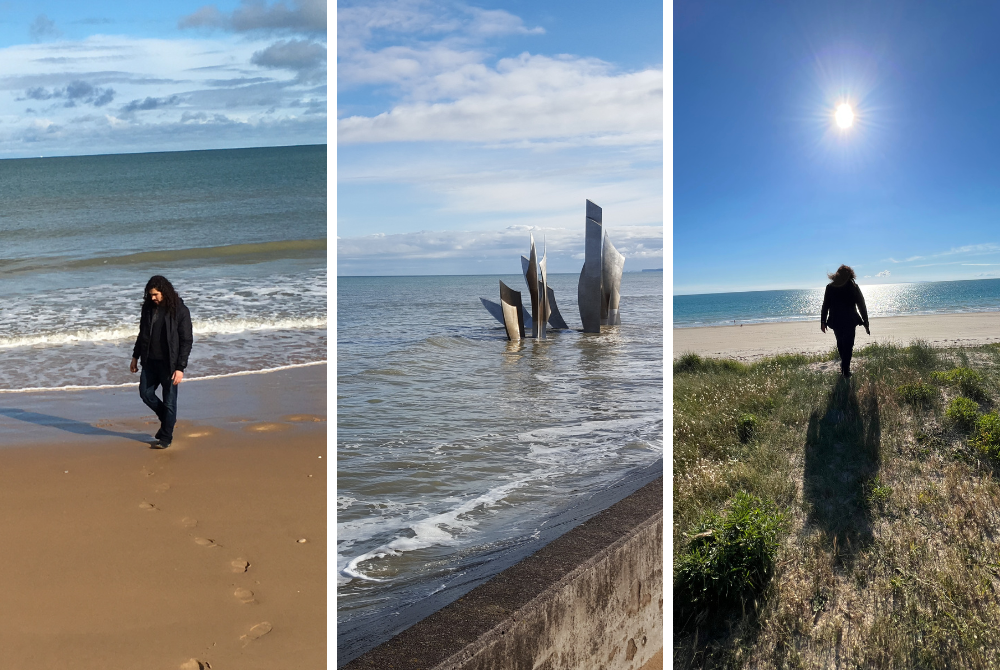
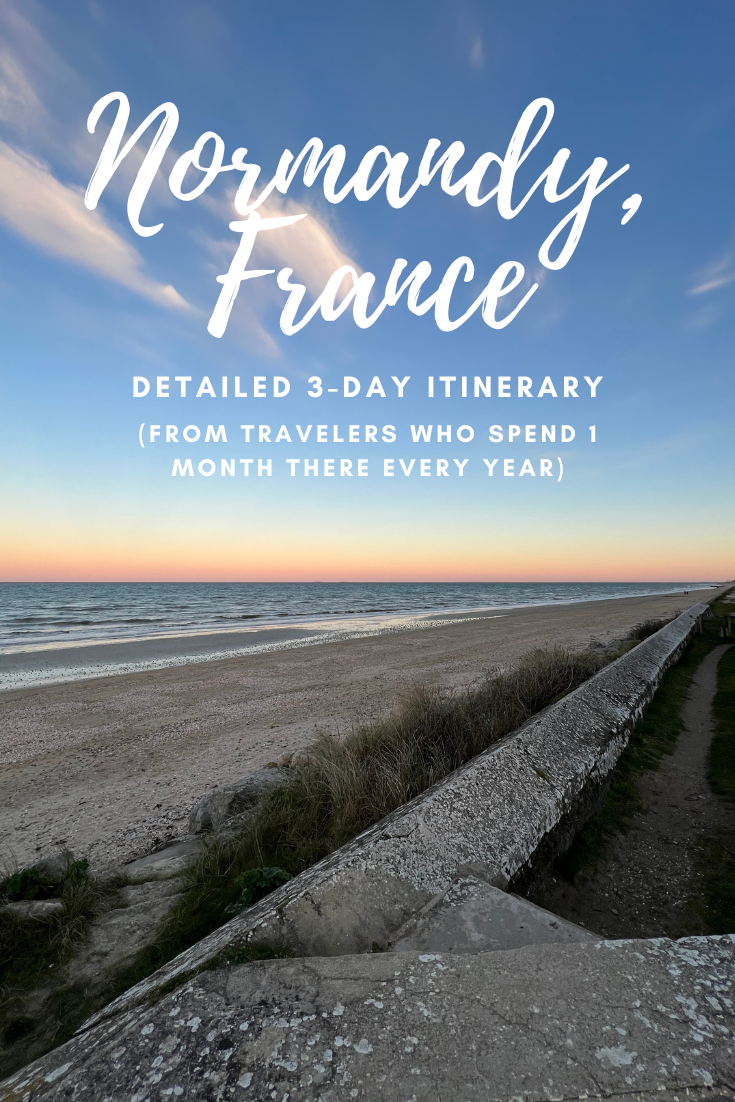

The invasion of Normandy was actually postponed because of weather – And that was July. Not much has changed on the stormy peninsula where the D-Day beaches of Normandy are located.
No… it was June 6, 44
Any tips renting a car and driving in Normandy from Caen ,do you need to purchase the SUPERPAK insurance seemingly every rental agency tries to hawk and what about the triple AAA international drivers license ? please share your thoughts.
Hi there! We’ve rented from the major companies like Hertz and Avis in Caen pretty easily. I do recommend getting the additional insurance if you are not using a credit card that has rental car coverage. You do not need a AAA international driver’s license to drive in France. Hope that was helpful and enjoy your trip!